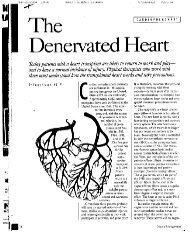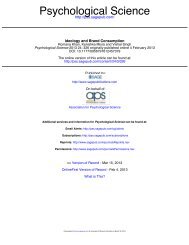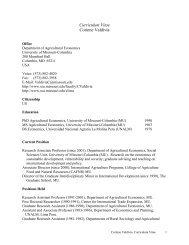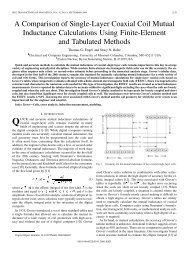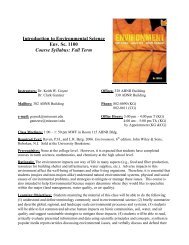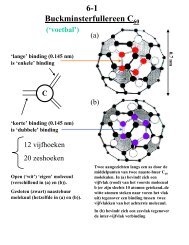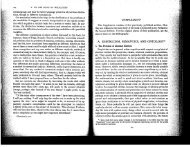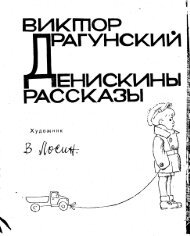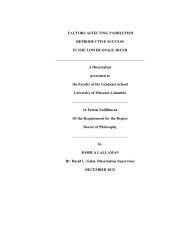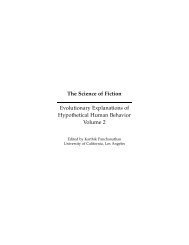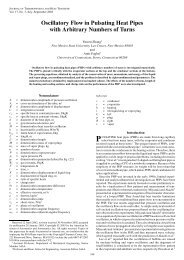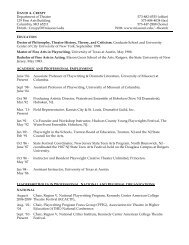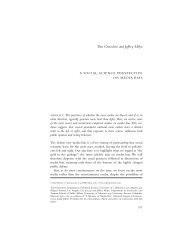Addressing common student misconceptions about static electricity ...
Addressing common student misconceptions about static electricity ...
Addressing common student misconceptions about static electricity ...
You also want an ePaper? Increase the reach of your titles
YUMPU automatically turns print PDFs into web optimized ePapers that Google loves.
<strong>Addressing</strong> <strong>common</strong> <strong>student</strong><br />
<strong>misconceptions</strong> <strong>about</strong> <strong>static</strong><br />
<strong>electricity</strong> and magnetism<br />
By Laurie Naab and David Henry<br />
Many of you have probably let your <strong>student</strong>s<br />
explore <strong>static</strong> charges by observing<br />
a balloon rubbed on hair sticking to<br />
the wall. But have you ever asked your<br />
<strong>student</strong>s why the balloon sticks to the wall? We created<br />
a set of motivating and meaningful <strong>static</strong> <strong>electricity</strong><br />
activities that can be used in grades 4–6. With<br />
Styrofoam plates and transparent tape, our <strong>student</strong>s<br />
investigated many properties of electrically charged<br />
and uncharged objects in a 5E learning-cycle model<br />
(engage, explore, explain, extend, and evaluate).<br />
Students were encouraged to make predictions<br />
throughout the investigations. In doing so, they<br />
were forced to focus when making observations<br />
and were more likely to recognize and change<br />
their <strong>misconceptions</strong>. Students’ explanations<br />
were also an essential piece to this unit. Students<br />
explained their predictions and new<br />
understandings in words and pictures.<br />
This helped them form more accurate<br />
mental models throughout<br />
the investigations.<br />
32 Science and Children
Common Student Misconceptions<br />
Using Wiggins and McTighe’s (1998) concept of Big<br />
Ideas, we planned and designed our <strong>electricity</strong> investigation<br />
to address <strong>common</strong> <strong>student</strong> <strong>misconceptions</strong> <strong>about</strong><br />
<strong>static</strong> <strong>electricity</strong> (Figure 1). Without a discussion <strong>about</strong><br />
why that balloon sticks to the wall after rubbing it on<br />
hair, many <strong>misconceptions</strong> may not be addressed. For<br />
example, <strong>student</strong>s may have the idea that there is only<br />
one kind of <strong>static</strong> charge. Giving them the opportunity<br />
to investigate both positively and negatively charged<br />
objects and electrically neutral objects allows them to<br />
build fundamental understanding of <strong>static</strong> <strong>electricity</strong>.<br />
Another <strong>common</strong> idea that begins to emerge in elementary<br />
school (Henry 2000) is that magnets are electrically<br />
charged, with the N-end being positively charged and<br />
the S-end being negatively charged. Magnets are <strong>common</strong>ly<br />
used in elementary school, but usually not when<br />
exploring <strong>static</strong> <strong>electricity</strong>. We have found that letting<br />
<strong>student</strong>s investigate magnets and <strong>static</strong> <strong>electricity</strong> together<br />
allows <strong>student</strong>s to observe that magnetism and<br />
<strong>static</strong> <strong>electricity</strong> are different things. After completing<br />
the following activities, <strong>student</strong>s use a Venn diagram<br />
or a comparison matrix to help them understand how<br />
magnetism and <strong>static</strong> <strong>electricity</strong> are alike and how they<br />
are different.<br />
Figure 1.<br />
Big ideas and <strong>misconceptions</strong>.<br />
Big Idea What I want my <strong>student</strong>s to think What my <strong>student</strong>s may be thinking<br />
Two charges Students understand that there are two<br />
kinds of charge, positive and negative.<br />
Static on surface Students understand that <strong>static</strong> <strong>electricity</strong><br />
is on the surface of a rubbed object<br />
and can be rubbed off.<br />
Like charges repel,<br />
opposite charges<br />
attract<br />
Students understand that opposite<br />
charges attract each other and like<br />
charges repel one another.<br />
Static attraction Students understand that <strong>static</strong> charged<br />
objects attract uncharged objects.<br />
Magnets aren’t<br />
charged<br />
Magnetism is internal,<br />
and is not a substance<br />
that can be imposed<br />
on an object.<br />
Students understand that, when interacting<br />
with a Styrofoam strip, magnets<br />
act as an uncharged object.<br />
Students understand that magnetism<br />
isn’t a substance that can be imposed<br />
on an object; it results simply from the<br />
rearrangement of particles within.<br />
Day 1: Engage With Static<br />
The unit began with a <strong>static</strong> <strong>electricity</strong> lesson designed to<br />
determine whether our <strong>student</strong>s held the <strong>common</strong> misconception<br />
that <strong>static</strong> <strong>electricity</strong> and magnetism are the<br />
same. A balloon is <strong>common</strong>ly used to introduce <strong>student</strong>s<br />
to <strong>static</strong> <strong>electricity</strong> and engage them in the topic, but because<br />
there were several children in our school district<br />
who had latex allergies, we needed to find an alternate<br />
object. Instead, we took a Styrofoam plate, pushed it up<br />
against the wall, let go, and it fell. We then rubbed it on a<br />
<strong>student</strong>’s hair and showed <strong>student</strong>s that it stuck it to the<br />
wall. This clearly indicated a change in the material. The<br />
rubbed Styrofoam plate gained electrons, resulting in a<br />
positive charge (human hair gives up electrons easily).<br />
We then asked the <strong>student</strong>s to describe (in writing and<br />
pictures) what happened and why. Their answers demonstrated<br />
to us that they believed that <strong>static</strong> <strong>electricity</strong><br />
and magnetism were related. Some of the <strong>student</strong>s’ responses<br />
included, “It stuck to the wall because the whiteboard<br />
has magnetism,” “The Styrofoam is a magnet,”<br />
and “I think it sticks because the Styrofoam has no north<br />
or south end, so it will always stick.” Statements such as<br />
these were clear evidence that there was a need for clarification<br />
of the similarities and differences between magnetism<br />
and <strong>static</strong> <strong>electricity</strong>. We ended this initial lesson<br />
Students are not aware that there are<br />
two kinds of charge.<br />
Students do not understand that <strong>static</strong><br />
<strong>electricity</strong> is on the surface of a rubbed<br />
object and can be rubbed off.<br />
Students do not understand that opposite<br />
charges attract each other and like<br />
charges repel one another.<br />
Students do not understand that <strong>static</strong><br />
charged objects attract uncharged objects.<br />
Students do not understand that, when<br />
interacting with a Styrofoam strip, magnets<br />
act as an uncharged object.<br />
Students believe that magnetism is a<br />
substance that can be imposed on<br />
an object.<br />
December 2009 33
Figure 2.<br />
Making T and B tapes.<br />
Step 1. Pull approximately 10 cm of tape from the dispenser.<br />
Make a tab (approximately 1 cm) on<br />
one end of the tape. Stick this tape to a desktop.<br />
Use a marker or pen to mark this tape B for<br />
bottom.<br />
Step 2. Repeat Step 1, putting the new piece of tape directly<br />
on top of the bottom tape. Label this tape<br />
T for top.<br />
Step 3. Carefully take the tab of the bottom tape and lift<br />
the tapes off of the desk. The two tapes should<br />
stay stuck together. At this point, the bottom<br />
tape is charged from lifting it from the table.<br />
Rub your fingers along the tape to make sure<br />
that the tapes are stuck together really well.<br />
Step 4. Take hold of the tabs from the T and B tapes<br />
and put them apart. The tapes will be charged<br />
and may wrap around your hand. Carefully<br />
hang the tapes approximately 5 cm apart from<br />
a meterstick or a similar material sticking out<br />
from a desk. Place a textbook on top of the meterstick<br />
to keep it stable.<br />
T<br />
B<br />
34 Science and Children<br />
Being pulled apart<br />
by posing the question, “What do we know <strong>about</strong> <strong>static</strong><br />
<strong>electricity</strong>?” Student responses were recorded in their science<br />
notebooks and on a class chart. Students noted that<br />
an object with <strong>static</strong> <strong>electricity</strong> sticks to other objects.<br />
The class chart was posted in the classroom and added to<br />
after each of the subsequent lessons.<br />
Day 2: Explore With Tape<br />
Next, we had <strong>student</strong>s explore for themselves with tape.<br />
Sticky transparent tape is an ideal material for <strong>static</strong> <strong>electricity</strong><br />
experiments because both positive and negative<br />
charges can be produced reliably by <strong>student</strong>s. When two<br />
pieces of transparent tape are placed on top of each other<br />
(sticky side to nonsticky side) and then separated, one<br />
piece becomes negatively charged and the other positively<br />
charged (for a thorough explanation of this phenomena,<br />
see Harrington 2000). Depending on the brand<br />
of tape used, one side of the tape is more likely to give up<br />
electrons, and the other side is more likely to keep them.<br />
We call these T and B tapes for “top” and “bottom.” Directions<br />
appear in Figure 2.<br />
Students created T and B tapes and then observed how<br />
they reacted when a piece of Styrofoam rubbed with hair<br />
or wool was brought near the tapes. Students recorded<br />
their results in a chart to be used in later discussion. Many<br />
<strong>student</strong>s were able to predict that one tape would be attracted<br />
to the rubbed Styrofoam and the other tape would<br />
be repelled. Eventually <strong>student</strong>s may discover that one<br />
tape is consistently negative and the other is positive,<br />
but it isn’t necessary for them to know this initially. At<br />
the fourth-grade level, <strong>student</strong>s are not required to know<br />
these terms.<br />
Day 3: Testing T and B Tapes<br />
We continued the day’s investigations with <strong>student</strong>s testing<br />
the interactions between two sets of T and B tapes.<br />
Students hung one set of T and B tapes on a meterstick<br />
and were instructed to bring a T tape close to both hanging<br />
tapes, and observe how the hanging tapes reacted<br />
(Figure 3). They recorded their observations in a chart.<br />
After being pulled apart<br />
T<br />
Students then brought a B tape close to both hanging<br />
+++++++++++ +++++++++++++<br />
- - - - -tapes, - -observed - - - how - - -the - hanging - - - tapes - - reacted, - - - and - -re -<br />
B<br />
corded their observations.<br />
- - - - - - - - - - - - - - - - - - - - -+++++++++++++ - +++++++++++++<br />
T<br />
B<br />
or<br />
- - - - - - - - - - - - -<br />
+++++++++++++<br />
Explaining Phenomena<br />
During this activity, <strong>student</strong>s observed that when like<br />
tapes (T–T and B–B) were brought close to each other,<br />
they repelled each other, and when opposite tapes were<br />
brought together (T–B tapes), they attracted each other.<br />
Students recorded their findings in a data table. Many<br />
<strong>student</strong>s connected this “opposites attract” concept to<br />
magnetism, and at this point in their investigation, they
PhotograPhs courtesy of the authors<br />
Figure 3.<br />
Testing T and B tapes.<br />
had not seen any evidence that did not support this idea.<br />
However, they did understand that there are two types of<br />
charges and how the two charges interacted. One group<br />
of <strong>student</strong>s wrote this explanation: “One tape has positive<br />
<strong>static</strong> in it and one tape has negative <strong>static</strong> in it. The<br />
tapes that have the same <strong>static</strong> repel, and if they have different<br />
<strong>static</strong> they attract.”<br />
In the next lesson, we extended the activity by having<br />
<strong>student</strong>s test interactions between the T and B tapes<br />
and other charged and uncharged objects. Students first<br />
observed what happened to the tapes when they brought<br />
their empty hand close to each of the tapes. They were<br />
surprised to see that both tapes were attracted to their hand<br />
and revealed their <strong>misconceptions</strong> <strong>about</strong> magnetism with<br />
comments like the following: “The tapes are still <strong>static</strong>, and<br />
I think in your hand is a magnet” and “When I put my hand<br />
near the tapes, the tapes attracted to my hand. The tapes are<br />
a magnet.” Students experimented with other uncharged<br />
objects such as pencils, water bottles, and scissors. In all<br />
cases, both charged tapes were attracted to the object.<br />
We then tested the tapes with objects that <strong>student</strong>s had<br />
rubbed with a piece of wool. Using plastic items such as<br />
plastic rulers, plastic plates, and Styrofoam plates assured<br />
that the <strong>student</strong>s would be testing objects with a good<br />
<strong>static</strong> charge. They observed that after the object was<br />
rubbed with wool, it would attract one tape and repel the<br />
other. Students explained that “when something is not<br />
rubbed with wool, it doesn’t have any <strong>static</strong> so it won’t<br />
repel anything, but when I rubbed things with wool, they<br />
got <strong>static</strong> so they can stick to things and repel things.”<br />
We found that the most important role for the teacher<br />
at this point is to be sure that all of the <strong>student</strong>s have<br />
observed how the two charged tapes behave differently<br />
when a wool-rubbed plate is brought close. Next, the<br />
teacher had <strong>student</strong>s work on an explanation of this ob-<br />
Why Static Clings<br />
servation. We let the <strong>student</strong>s work in groups using large<br />
dry erase presentation boards. When <strong>student</strong>s presented<br />
their explanations to the class, the teacher clarified and<br />
reworded the explanations, and helped the class make<br />
connections from one explanation to the next. We found<br />
that <strong>student</strong>s were aware that there are two types of<br />
charges. They were aware that opposite charges attract<br />
and like charges repel. However, most <strong>student</strong>s still had<br />
the misconception (as a result of the prior knowledge and<br />
experience with magnets) that magnets and <strong>static</strong> <strong>electricity</strong><br />
have the same type of “charge.” The next activity<br />
was designed to help them separate their mental models<br />
of magnetism and <strong>static</strong> <strong>electricity</strong>.<br />
Extend With Magnets<br />
Students tested T and B tapes with a magnet (Figure 4)<br />
after making predictions of what they thought would<br />
happen if they brought a north end or a south end of a<br />
magnet toward each of the tapes. A majority predicted<br />
that the north end of a magnet would attract one of the<br />
tapes and repel the other tape. One <strong>student</strong> explained,<br />
“I think the tape will attract to one end of the magnet<br />
because the tape is a magnet and it will repel the other<br />
tape because on a magnet one side attracts and the other<br />
side repels.” The <strong>student</strong>s were surprised when they observed<br />
that the north end of the magnet attracted both<br />
the T and B tapes! This surprise played a major role in<br />
reversing their <strong>misconceptions</strong> that they held at the beginning<br />
of this unit. After predicting and then testing the<br />
T and B tapes with the south end of the magnet, our <strong>student</strong>s<br />
had a better understanding that when interacting<br />
with T and B tapes, a magnet acts as an uncharged object<br />
and, more importantly, that magnetism is different from<br />
<strong>static</strong> charge. One <strong>student</strong> explained, “The tapes have<br />
Figure 4.<br />
Testing tape with a magnet.<br />
December 2009 35
Why Static Clings<br />
no north end or south end because they are not magnets,<br />
so the magnet will always stick to the tapes.” This statement<br />
is one indication that the <strong>student</strong>s began to recognize<br />
that the magnet acted as an uncharged object and<br />
therefore attracts both of the tapes.<br />
Day 4: Evaluate Understanding<br />
After determining <strong>student</strong>s’ initial ideas of why a hairrubbed<br />
piece of Styrofoam sticks to the wall in the preassessment,<br />
it was essential to pose the same question to<br />
see whether the unit’s instruction altered their mental<br />
models of this phenomenon. When asked again why a<br />
wool or hair-rubbed Styrofoam plate sticks to the wall,<br />
most <strong>student</strong>s were able to give an explanation that the<br />
wall acts as a neutral object just like our hands or other<br />
(uncharged) objects. After completing these lessons, the<br />
change in our <strong>student</strong>s’ understanding of the concept of<br />
<strong>static</strong> <strong>electricity</strong> was clear. When we reviewed the <strong>student</strong>s’<br />
science journals and group presentation boards,<br />
we found that <strong>student</strong>s were able to explain that there<br />
36 Science and Children<br />
PhotograPh courtesy of the authors<br />
Connecting to the Standards<br />
This article relates to the following National Science<br />
Education Standards (NRC 1996):<br />
Content Standards<br />
Grades K–4<br />
Standard A: Science as Inquiry<br />
• Abilities necessary to do scientific inquiry<br />
Standard B: Physical Science<br />
• Properties of objects and materials<br />
National Research Council (NRC). 1996. National<br />
science education standards. Washington, DC:<br />
National Academies Press.<br />
are two kinds of charge, that like charges repelled each<br />
other, and that opposite charges attracted each other.<br />
Students were also able to identify the similarities and<br />
differences between <strong>static</strong> <strong>electricity</strong> and magnetism,<br />
including an understanding that <strong>static</strong> <strong>electricity</strong> and<br />
magnetism are similar but distinct phenomena. Both<br />
magnetism and <strong>static</strong> <strong>electricity</strong> follow the likes repel<br />
and opposites attract rule, but they are different because<br />
magnets act like uncharged objects and charged<br />
objects do not act magnetic.<br />
Misconceptions Not Sticking<br />
These inquiry-based investigations were powerful<br />
because the <strong>student</strong>s were able to create their own<br />
understanding of <strong>static</strong> <strong>electricity</strong> through their own<br />
observations—and therefore create a more accurate<br />
mental model of <strong>static</strong> <strong>electricity</strong>. These activities also<br />
let the <strong>student</strong>s experience doing science as they gathered,<br />
recorded, and debated evidence. They started<br />
with ideas, and they changed their ideas based on their<br />
observations. We think the lesson will “stick!” n<br />
Laurie Naab (lnaab@lancaster.wnyric.org) is a fourthgrade<br />
teacher at William Street School in Lancaster,<br />
New York. David Henry (henryd@buffalostate.edu)<br />
is an associate professor in elementary education at Buffalo<br />
State College.<br />
References<br />
Harringon, R. 2000. Getting a charge out of transparent tape.<br />
The Physics Teacher 38:23–25.<br />
Henry, D. 2000. Learning <strong>about</strong> <strong>static</strong> <strong>electricity</strong> and magnetism<br />
in a fourth-grade class. PhD diss., University of<br />
Buffalo.<br />
Wiggins, G., and J. McTighe. 1998. Understanding by design.<br />
Alexandria, VA: Association for Supervision and Curriculum<br />
Development.



